
His pyramid was the Pyramid of the Sun in Teotihuacan
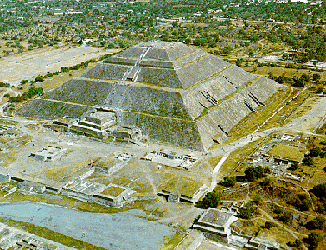
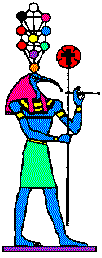
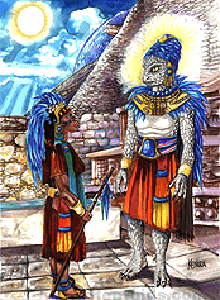
The ancient Maya had a complex pantheon of deities whom they worshipped and offered human sacrifices. Rulers were believed to be descendants of the gods and their blood was the ideal sacrifice, either through personal bloodletting or the sacrifice of captives of royal blood. The Mayan vision of the universe is divided into multiple levels, above and below earth, positioned within the four directions of north, south, east and west. After death, the soul was believed to go to the Underworld, Xibalba (shee bal bah), a place of fright where sinister gods tested and tricked their unfortunate visitors.
As with all Myths about Gods and Goddesses - Mayan creational mythology discuss connections with being from other realms who came to Earth to seed the planet. Many people connect the story of the Popol Vuh with a story of extraterrestrial Gods who came to earth and made man in their own image. When they first created man, he was perfect, living as long as the gods and having all of their abilities. Fearing their 'creation', the gods destroyed them. In the next evolution, a lower form of entity was created, 'human', as he exists today. Within Mayan culture they have legends of visiting Gods from outer space. As in all creational myths, religions, and prophecies, the gods promise to return one day.

His pyramid was the Pyramid of the Sun in Teotihuacan



Kukulcan was identified to Atlantis [Tehuti] -- Egypt [Thoth] -- Sumer [Ea or Enki] -- then later to Mesoamerica and Peru as Quetzalcoatl.
Quetzalcoatl ("feathered snake") is the Aztec name for the Feathered-Serpent deity of ancient Mesoamerica, one of the main gods of many Mexican and northern Central American civilizations.
The name "Quetzalcoatl" literally means quetzal-bird snake or serpent with feathers of the Quetzal (which implies something divine or precious) in the Nahuatl language. The meaning of his local name in other Mesoamerican languages is similar.
The Maya knew him as Kukulkna; the Quiche as Gukumatz. The Feathered Serpent deity was important in art and religion in most of Mesoamerica for close to 2,000 years, from the Pre-Classic era until the Spanish Conquest.
Gukumatz was a culture hero who taught the Toltecs, and later the Maya, the arts of civilization, including codes of law, agriculture, fishing and medicine. He came from an ocean, and eventually returned to it. According to Mayan legend, Gukumatz will return to the Earth during the End Times. He also represents the forces of good and evil, similar to the ying-yang paradigm of Oriental religions.
Gukumatz was a god of the four elements of fire, earth, air and water, and each element was associated with a divine animal or plant:
Air -- Vulture
Earth -- Maize
Fire -- Lizard
Water -- Fish
The worship of Quetzalcoatl sometimes included human sacrifices, although in other traditions Quetzalcoatl was said to oppose human sacrifice.
Mesoamerican priests and kings would sometimes take the name of a deity they were associated with, so Quetzalcoatl and Kukulcan are also the names of historical persons.
In the 10th century a ruler closely associated with Quetzalcoatl ruled the Toltecs; his name was Topiltzin Ce Acatl Quetzalcoatl. This ruler was said to be the son of either the great Chichimeca warror, Mixcoatl and the Colhuacano woman Chimalman, or of their descendant.
The Toltecs had a dualistic belief system. Quetzalcoatl's opposite was Tezcatlipoca, who supposedly sent Quetzalcoatl into exile. Alternatively, he left willingly on a raft of snakes, promising to return. When the Aztecs adopted the culture of the Toltecs, they made twin gods of Tezcatlipoca and Quetalcoat, opposite and equal; Quetalcoatl was also called White Tezcatlipoca, to contrast him to the black Tezcatlipoca. Together, they created the world; Tezcatlipoca lost his foot in that process.
The Aztec Emperor Moctezuma II initially believed the landing of Cortez in 1519 was Quetzalcoatl's return. Cortes played off this belief to aid in his conquest of Mexico. The exact significance and attributes of Quetzalcoatl varied somewhat between civilizations and through history. Quetzalcoatl was often considered the god of the morning star and his twin brother, Xolotl was the evening star (Venus). As the morning star he was known under the title Tlahuizcalpantecuhtli, which means literaly "the lord of the star of the dawn". He was known as the inventor of books and the calendar, the giver of maize corn to mankind, and sometime as a symbol of death and resurrection. Quetzalcoatl was also the patron of the priests and the title of the Aztec high priest.
Most Mesoamerican beliefs included cycles of worlds. Usually, our current time was considered the fifth world, the previous four having been destroyed by flood, fire and the like. Quetzalcoatl allegedly went to Mictlan, the underworld, and created fifth world-mankind from the bones of the previous races (with the help of Cihuacoatl), using his own blood to imbue the bones with new life.
His birth, along with his twin Xolotl, was unusual; it was a virgin birth, born to the goddess Coatlicue. Alternatively, he was a son of Xochiquetzal and Mixcoatl.
One Aztec story claims Quetzalcoatl was seduced by Tezcatlipoca but then burned himself to death out of remorse. His heart became the morning star.
Quetzalcoatl was a god of such importance and power that nearly no aspect of everyday life seemed to go untouched by him. Secondly, as a historical figure, his actions would nor could not be contained by the History and thus eventually evolved into myth. As a legend, he would signal the end of mortal kingship. An interesting phenomena that distinguished Quetzalcoatl is that despite the fact he is not the most powerful of gods within the Mesoamerican pantheon, or one of the eldest, he is nonetheless an integral part of the system. This was partially accomplished by his ability to integrate himself so securely to attributes of his fellow brethren, to such an extent that it is virtually impossible to tell if Quetzalcoatl was the true originator or vise versa. Hence, to establish a single definitive personality to a god is extremely difficult.
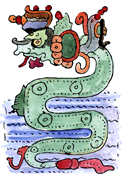
In Maya mythology, Chac (sometimes spelled "Chaac") was the god of rain and thunder, and important as a fertility and agriculture god. Like some other Maya gods, Chac was sometimes thought of as one god, and other times as 4 separate gods based in the four cardinal directions: "Chac Xib Chac", Red Chac of the East; "Sac Xib Chac", White North Chac; "Ek Xib Chac" Black West Chac", and "Kan Xib Chac", Yellow East Chac.
In art, he was sometimes depicted as an old man with some reptilian or amphibian features, with fangs and a long nose, sometimes tears coming from his eyes (symbolizing rain) and carrying an axe (which caused thunder). He was associated with the frog. Other Maya terms used to refer to Chac include Ah Tzenul, ("he who gives food away to other people"), Hopop Caan ("he who lights the sky"), and Ah Hoya ("he who urinates").Names for the Rain God in other Mesoamerican cultures include Cocijo (Zapotec) and Tlaloc (Aztec).
While most of the ancient Mesoamerican gods are long forgotten by the descendants of the original inhabitants today, prayers to the Chaacs, most generally as a routine and not in times of drought, are documented in Yucatán as continuing into the 21st century among nominal Christian Maya farmers. Anthropologists have documented other prayers still in use which are identical to pre-Columbian prayers to Chac except that the name Chac has been replaced by that of Saint Thomas.Chac should not be confused with the Maya-Toltec figure Chac Mool.
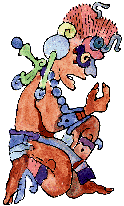
Kinich Ahau was the Sun god. He was the patron god of the city Itzamal. Supposedly, he visited the city at noon everday. He would descend as a macaw and consume prepared offerings. Kinich Ahau is usually shown with jaguar-like features (ex. filed teeth). Kinich Ahau also wears the symbol of Kin, a Mayan day. Kinich Ahau was also know by the name Ah Xoc Kin, who was associated with poetry and music.
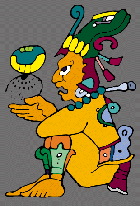
The Maize god is representative of the ripe grain which was the base of the Mayan agriculture. In certain areas of Mesoamerica, like Yucatan, the Maize god is combined with the god of flora, Yumil Kaxob. The Maize god is principally shown with a headdress of maize and a curved streak on his cheek. He is also noticeable from other gods throug his youth. Despite this youth, the Maize god was powerless by himself. His fortunes and misfortunes were decided by the control of rain and drought. The Rain god would protect him. However, he suffered when the Death god exercised drought and famine.
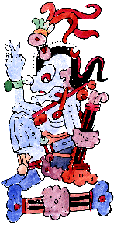
The death god was called Yum Cimil. He also could be called Ah Puch, the god of the Underworld. His body is predominantly skeletal. His adornments are likewise made of bones. Yum Cimil has also been represented with a body covered with black spots (decomposition). He also wears a collar with eyeless sockets. This adornment was the typical symbol for the Underworld.

The suicide goddess was called Ixtab. She is always represented with a rope around her neck. The Mayans believed that suicides would lead you to heaven. Hence, it was very common for suicides to happen because of depression or even for something trivial.
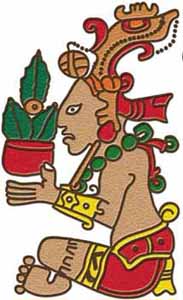
In Maya mythology, Yum Caax ("lord of the woods") was the personification of maize and a god of agriculture and nature.Alternative names: Yum Kaax, God E.Perhaps having origins in ancient northern hunting tradition, Yum Ka'ax, also called U Kanin Ka'ax, is known to indigenous peoples of North America. The one invoked by hunters, he is owner of all the game. He can appear to hunters in an instant, and possesses songs that will allow a hunter success or allow his arrows to come back to him.
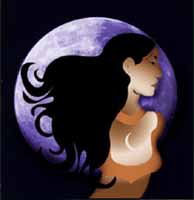
Ix Chel, the Lady Rainbow - in Maya mythology, Ixchel or Ix Chel was an earth and moon goddess, patroness of weavers and pregnant women.One myth states that the sun was her "lover," but that her grandfather was very upset with this and he threw lightining at her out of jealousy which in turn killed Ix Chel.
In the story it stated that dragonflies sang over her for 183 days and then she awoke again only to follow the sun to his palace. But the sun soon after too started to become jealous of Ix Chel, thinking that she was having an affair with the morning star, who was the sun's brother. The sun threw her out of heaven and then persuaded her back home, but soon after her return he became jealous again. It is said that Ix Chel became annoyed with the bahavior of the sun and so she went off into the night and remained invisible whenever the sun came around. At her new place in the night it is said that Ix Chel spent the nights nursing women of Earth through their labor (during the stint of their pregnancy and birth).
The story of Ix Chel and Itzamna shows both interesting similarities and differences with the Japanese myth of Izanagi and Izanami. The names and personalities are reversed in one version of the story as compared to the other. Izanami is the female, and she is the one who violently attacks her husband. Ix Chel was said to pay special attention to the pilgrims who visited Cozumel, which was her sacred island. Isla Mujeres was also devoted to her worship.
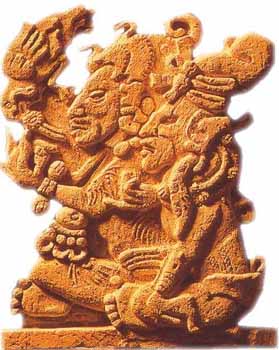
In Maya mythology, Ixbalanque or Xbalanque was originally a son of Hun Hunahpu and the virgin Blood Moon. His twin was Hunahpu. The two were the Maya Hero Twins and together their story forms a large part of the Popol Vuh, documenting the Mayan creation myth. Xbalanque and his brother Hunahpu were quite inseperable in their lives, together outwitting arrogant gods and the lords of the Mayan underworld, Xibalba. Although it is not explicitly stated in the Popol Vuh, Hunahpu seems to have been the dominant one among the brothers, often the one to do the talking and the planning, although Xbalanque was not merely a hapless sidekick. Xbalanque is credited with saving his older brother's life at least once. Xbalanque ascended to the heavens after his death and became associated with the full moon. Xbalanque is sometimes referred to as the Mayan moon goddess, having switched genders in those versions of the myth.
In Maya mythology, Hun-Apu or Hunahpu was a son of Hun Hunahpu and Blood Moon, and an older twin to Xbalanque; the two were the Maya Hero Twins. The story of Hunahpu and his brother are told in the Popol Vuh. The pair were apparently well favored by the greater Mayan gods, and over their lifetimes had a long career of defeating their enemies through trickery and great powers.
Hunahpu and his brother were conceived in an unusual fashion, when their mother Blood Moon spoke with the decapitated head of their father Hun Hunahpu. The skull spat upon the maiden's hand, and it was this act that caused the twins to be conceived in her womb. Blood Moon sought out Hun Hunahpu's mother, who begrudgingly took her in after setting up a number of trials to prove her identity.
Even after birth, Hunahpu and Xbalanque were not well treated by their grandmother or their older half-brothers One Monkey and One Artisan. Immediately after their births, their grandmother demanded they be removed from the house due to their crying, and their elder brothers obliged by placing them in unusual places to sleep; on an anthill and among the brambles. Their intent was to kill their younger half-brothers out of jealousy and spite, for the older pair had long been revered as fine artisans and thinkers, and feared the newcomers would steal from the attention they received.
The attempts to kill the young twins after birth were a failure, and the boys grew up without any obvious spite for their ill-natured older siblings. During their younger years, the twins were made to labor, going to hunt birds which they brought back for meals. The elder brothers were given their food to eat first, in spite of the fact they spend the day singing and playing while the younger twins were working.
Hunahpu and Xbalanque demonstrated their wit at a young age in dealing with their older half brothers. One day the pair returned from the field without any birds to eat, and were questioned by their older siblings. The younger boys claimed that they had indeed shot several birds but that they had gotten caught high in a tree and were unable to retrieve them. The older brothers were brought to the tree and climbed up to get the birds, when the tree suddenly began to grow even taller, and the older brothers were caught. This is also the first instance in which the twins demonstrate supernatural powers, or perhaps simply the blessings of the greater gods; the feats of power are often only indirectly attributed to the pair.
Hunahpu further humiliated his older brethren by instructing them to remove their pants and tie them about their waists in an attempt to climb down. The pants became tails, and the brothers were transformed into monkeys. When their grandmother was informed that the older boys had not been harmed, she demanded they be allowed to return. When they did come back to the home, their grandmother was unable to contain her laughter at their appearance, and the disfigured brothers ran away in shame.
At a point in their lives not specified in the Popol Vuh, the twins were approached by the god Huracan regarding an arrogant god named Seven Macaw (Vucub Caquix). Seven Macaw had built up a following of worshipers among some of the inhabitants of the Earth, making false claims to be either the sun or the moon. Seven Macaw was also extremely vain, adorning himself with metal ornaments in his wings and a set of false teeth made of gemstones.In a first attempt to dispatch the vain god, the twins attempted to sneak upon him as he was eating his meal in a tree, and shot at his jaw with a blowgun. Seven Macaw was knocked from his tree but only wounded, and as Hunahpu attempted to escape, his arm was grabbed by the god and torn off.
In spite of their initial failure, the twins again demonstrated their clever nature in formulating a plan for Seven Macaw's defeat. Invoking a pair of gods disguised as grandparents, the twins instructed the invoked gods to approach Seven Macaw and negotiate for the return of Hunapuh's arm. In doing so, the "grandparents" indicated they were but a poor family, making a living as doctors and dentists and attempting to care for their orphaned grandchildren. Upon hearing this Seven Macaw requested that his teeth be fixed since they had been shot and knocked loose by the blowgun, and his eyes cured (it is not specifically said what ailed his eyes). In doing so the grandparents replaced his jeweled teeth with white corn, and plucked the ornaments he had about his eyes, leaving the god destitute of his former greatness. Having fallen, Seven Macaw died, presumably of shame.
Seven Macaw's sons, Zipacna and Cabrakan, inherited a large part of their father's arrogance, claiming to be the creators and destroyers of mountains, respectively. The elder son Zipacna was destroyed when the twins tricked him with the lure of a fake crab, burying him beneath a mountain in the process. More detail regarding Zipacna's deeds and his defeat can be found in the article about Zipacna.
The Mayan god Huracan again implored the young twins for help in dealing with Seven Macaw's younger son, Cabrakan, the Earthquake. Again it was primarily through their cleverness that the pair were able to bring about the downfall of their enemy, having sought him out and then using his very arrogance against him; they told the story of a great mountain they had encountered that kept growing and growing. Cabrakan prided himself as the one to bring down the mountains, and upon hearing such a tale, he predictably demanded to be shown the mountain. Hunahpu and Xbalanque obliged, leading Cabrakan toward the non-existent mountain. Being skilled hunters, they shot down several birds along the way, roasting them over fires and playing upon Cabrakan's hunger. When he asked for some meat, he was given a bird that had been prepared with plaster and gypsum, apparently a poison to the god. Upon eating it, he was weakened, and the boys were able to bind him and cast him into a hole in the earth, burying him forever.
Hunahpu and Xbalanque played ball in the same court that their father and his brother had played in long before them. When One Hunahpu and his brother had played, the noise had disturbed the Lords of Xibalba, rulers of the Mayan underworld. The Xibalbans summoned them to play ball in their own court. Doing so was a trap, however, as the Xibalbans used a bladed ball which was used to kill and decapitate the young men for disturbing their peace.When the twins began to play ball in the court, once again the Lords of Xibalba were disturbed by the racket, and sent summons to the boys to come to Xibalba and play in their court. Fearing they would suffer the same fate, their grandmother relayed the message only indirectly, telling it to a louse which was hidden in a toad's mouth, which was in turn hidden in the belly of a falcon. Nevertheless the boys did receive the message, and much to their grandmother's dismay, set off to Xibalba.
When their father had answered the summons, he and his brother were met with a number of challenges along the way which served to confuse and embarrass them before their arrival, but the younger twins would not fall victim to the same tricks. They sent a mosquito ahead of them to bite at the Lords and uncover which were real and which were simply mannequins, as well as uncovering their identities. When they arrived at Xibalba they were easily able to identify which were the real Lords of Xibalba and address them by name. They also turned down the Lords' invitation to sit upon a bench for visitors, correctly identifying the bench as a heated stone for cooking. Frustrated by the twins' ability to see through their traps, they sent the boys away to the Dark House, the first of several deadly tests devised by the Xibalbans.
Their father One Hunahpu and his brother had suffered embarrassing defeats in each of the tests, but again Hunahpu and Xbalanque demonstrated their prowess by outwitting the Xibalbans on the first of the tests, surviving the night in the pitch black house without using up their torch. Dismayed, the Xibalbans bypassed the remaining tests and invited the boys directly to the game. The twins knew that the Xibalbans used a special ball that had a blade with which to kill them, and instead of falling for the trick Hunahpu stopped the ball with a racket and spied the blades. Complaining that they had been summoned only to be killed, Hunahpu and Xbalanque threatened to leave the game.
As a compromise, the Lords of Xibalba allowed the boys to use their own rubber ball, and a long and proper game ensued. In the end the twins allowed the Xibalbans to win the game, but this was again a part of their ruse. They were sent to Razor House, the second deadly test of Xibalba, filled with knives that moved of their own accord. The twins however spoke to the knives and convinced them to stop, thereby ruining the test. They also sent leafcutting ants to retrieve petals from the gardens of Xibalba, a reward to be offered to the Lords for their victory. The Lords had intentionally chosen a reward they thought impossible, for the flowers were well guarded, but the guards did not take notice of the ants, and were killed for their inability to guard the flowers.
The twins played a rematch with the Xibalbans and lost by intent again, and were sent to Cold House, the next test. This test they defeated, as well. In turn, Hunahpu and Xbalanque by purpose lost their ball games so that they might be sent to the remaining tests, Jaguar House, Fire House, Bat House and in turn defeat the tests of the Xibalbans. The Lords of Xibalba were dismayed at the twins success, until the twins were placed in Bat House. Though they hid inside their blowguns from the deadly bats, Hunahpu peeked out to see if daylight had come, and was decapitated by a bat.The Xibalbans were overjoyed that Hunahpu had been defeated. Xbalanque summoned the beasts of the field, however, and fashioned a replacement head for Hunahpu. Though his original head was used as the ball for the next day's game, the twins were able to surreptitiously substitute a squash or a gourd for the ball, retrieving Hunahpu's real head and resulting in an embarrassing defeat for the Xibalbans.
Embarrassed by their defeat the Xibalbans still sought to destroy the twins. They had a great oven constructed and once again summoned the boys, intending to trick them into the oven and to their deaths. The twins realized that the Lords had intended this ruse to be the end of them, but nevertheless they allowed themselves to be burned in the oven, killed and ground into dust and bones. The Xibalbans were elated at the apparent demise of the twins, and cast their remnants into a river. This was, however, a part of the plan devised by the boys, and when cast into the river their bodies regenerated, first as a pair of catfish, and then as a pair of young boys again.Not recognizing them, the boys were allowed to remain among the Xibalbans.
Tales of their transformation from catfish spread, as well as tales of their dances and the way they entertained the people of Xibalba. They performed a number of miracles, setting fire to homes and then bringing them back whole from the ashes, sacrificing one another and rising from the dead. When the Lords of Xibalba heard the tale, they summoned the pair to their court to entertain them, demanding to see such miracles in action.The boys answered the summons, and volunteered to entertain the Lords at no cost. Their identities remained secret for the moment, claiming to be orphans and vagabonds, and the Lords were none the wiser. They went through their gamut of miracles, slaying a dog and bringing it back from the dead, causing the Lords' house to burn around them while the inhabitants were unharmed, and then bringing the house back from the ashes. In a climactic performance, Xbalanque cut Hunahpu apart and offered him as a sacrifice, only to have the older brother rise once again from the dead.
Enthralled by the performance, One Death and Seven Death, the highest lords of Xibalba, demanded that the miracle be performed upon them. The twins obliged by killing and offering the lords as a sacrifice, but predictably did not bring them back from the dead. The twins then shocked the Xibalbans by revealing their identities as Hunahpu and Xbalanque, sons of One Hunahpu whom they had slain years ago along with their uncle Seven Hunahpu. The Xibalbans despaired, confessed to the crimes of killing the brothers years ago, and begged for mercy. As a punishment for their crimes, the realm of Xibalba was no longer to be a place of greatness, and the Xibalbans would no longer receive offerings from the people who walked on the Earth above. All of Xibalba had effectively been defeated.
With Xibalba defeated and the arrogant gods disposed of, Hunahpu and Xbalanque had one final act to accomplish. They returned to the Xibalban ball court and retrieved the buried remains of their father, One Hunahpu, and attempted to rebuild him. Although his body was made whole again he was not the same, and was unable to function as he once did. The twins left their father there in the ball court, but before doing so told him that he would be prayed to by those who sought hope, and this eased his heart.
Then finished, the pair departed Xibalba and climbed back up to the surface of the Earth. They did not stop there, however, and continued climbing straight on up into the sky. Hunahpu was immortalized as the Venus, the morning star, while Xbalanque became the full moon.
While not directly revered as gods themselves, Hunahpu and Xbalanque played an integral role in the Mayan creation story as being of superhuman stature, perhaps demigods or minor deities themselves, always favored by the greater gods. Although many of their acts and successes came about as a result of trickery and deceit, this was viewed more as cleverness than dishonesty, and their roles in defeating the vain and arrogant gods as well as the evil lords of the underworld Xibalba solidifies their characters as being that of good.
Ah Puch: the god of Death.
Ahau Chamahez: one of two gods of Medicine.
Ahmakiq: a god of Agriculture who locks up the wind when it threatens to destroy the crops.
Akhushtal: the goddess of Childbirth
Bacabs - are the canopic gods, thought to be brothers, who, with upraised arms, supported the multilayered sky from their assigned positions at the four cardinal points of the compass. (The Bacabs may also have been four manifestations of a single deity.) The four brothers were probably the offspring of Itzamná, the supreme deity, and Ixchel, the goddess of weaving, medicine, and childbirth. Each Bacab presided over one year of the four-year cycle. The Maya expected the Muluc years to be the greatest years, because the god presiding over these years was the greatest of the Bacab gods. The four directions and their corresponding colors (east, red; north, white; west, black; south, yellow) played an important part in the Mayan religious and calendrical systems.
Mayan god of rain, especially important in the Yucatan region of Mexico where he was depicted in Classic times with protruding fangs, large round eyes, and a proboscis-like nose. In post-Classic Mayan and Toltec ruins, reclining figures known as the Chacs Mool are thought to represent the rain god. Following the Spanish conquest, the Chacs were associated with Christian saints and were often depicted on horseback.
Cit Bolon Tum: a god of Medicine.
Cizin (Kisin): "Stinking One"; Mayan earthquake god and god of death, ruler of the subterranean land of the dead. He lives beneath the earth in a purgatory where all souls except those of soldiers killed in battle and women who died in childbirth spend some time. Suicides are doomed to his realm for eternity. He may possibly have been one aspect of a malevolent underworld deity who manifested himself under several names and guises (e.g., Ah Puch, Xibalba, and Yum Cimil). In pre-Conquest codices, or manuscripts, the god of death is frequently depicted with the god of war in scenes of human sacrifice. One aspect of the dualistic nature of the Mayan religion is symbolically portrayed in the existing codices, which show Cizin uprooting or destroying trees planted by Chac, the rain god. Cizin is often depicted on pottery and illustrated in the codices in the form of a dancing skeleton, holding a smoking cigarette. He is also known by his death collar, the most prominent feature of which consists of disembodied eyes dangling by their nerve cords. After the Spanish Conquest, Cizin became merged with the Christian devil.
Ekahau: the god of Travelers and Merchants.
Itzamn: "Iguana House" - Principal pre-Columbian Mayan deity. The ruler of heaven, day, and night, he frequently appeared as four gods called Itzamnas, who encased the world. Like some of the other Mesoamerican deities, the Itzamnas were associated with the points of the compass and their colors (east, red; north, white; west, black; and south, yellow). Itzamna was sometimes identified with the remote creator deity Hunab Ku and occasionally with Kinich Ahau, the sun-god. The moon goddess Ixchel, patroness of womanly crafts, was possibly a female manifestation of the god. Itzamná was also a culture hero who gave humankind writing and the calendar and was patron deity of medicine.
Ixtab: the goddess of the Hanged. She receives their souls into paradise.
Kan-u-Uayeyab: the god who guarded cities.
Kinich Kakmo: the Sun god symbolised by the Macaw.
Kisin:
Mitnal: Mitnal was the underworld hell where the wicked were tortured.
Nacon: Nacon was the god of War.
Tzultacaj (Tzuultaq'ah): For the Mayan Indians of central Guatemala, known as Kekchl, this was the god of the mountains and valleys.
Yaxche: Yaxche is the Tree of Heaven under which good souls rejoice.
Other Notable Gods - First Humans - Gods and Supernatural Beings